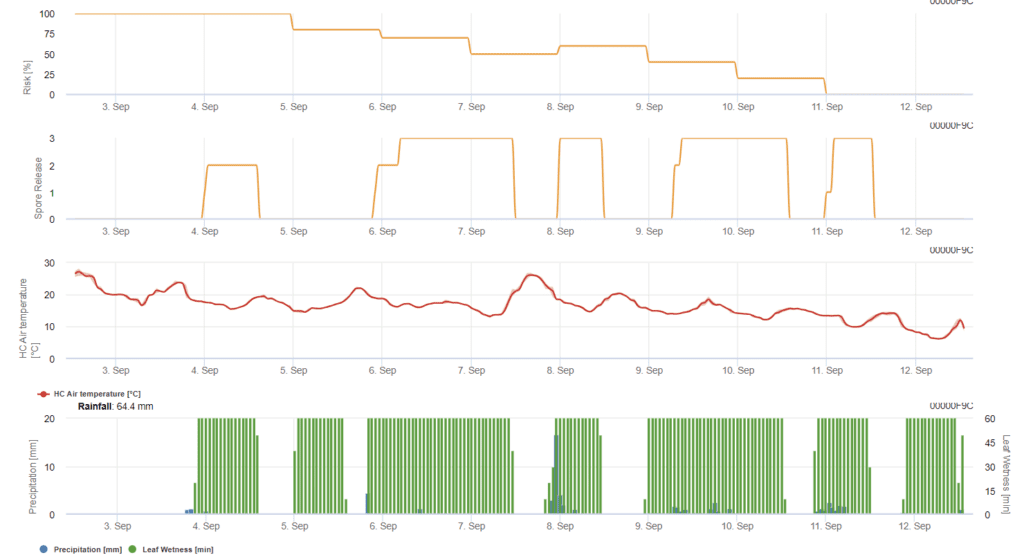
Orzech laskowy modele choroby
Monilinia
Patogen
Rodzaj Monilinia obejmuje kilka gatunków grzybów, które powodują brązową zgniliznę w różnych uprawach owoców, takich jak Monilinia coryli, Monilinia laxaoraz Monilinia fructigena. Grzyby te mają wspólne cechy, w tym wytwarzanie apotecjów z pseudosklerocjów, które tworzą się w zmumifikowanych owocach lub innych szczątkach roślinnych.
Cykl chorobowy Monilinia obejmuje trzy etapy:
- zaraza kwiatów i rak gałązek wczesną wiosną,
- aktywna brązowa zgnilizna późną wiosną i latem oraz
- obecność zmumifikowanych owoców pozostających na drzewie lub w glebie.
Zimowanie następuje w zainfekowanych owocach lub rakach gałązek, które służą jako rezerwuar patogenu. Wiosną, Monilia gatunki uwalniają askospory i konidia, pierwotne inokulum, które są rozpraszane przez wiatr lub deszcz.
Gdy zarodniki wylądują na podatnych tkankach roślinnych, takich jak kwiaty i ostrogi owoców, infekcja może się szybko rozprzestrzeniać, szczególnie w wilgotnych warunkach. Zgnilizna owoców może rozwijać się szybko, a infekcja może pozostać utajona do czasu dojrzewania owoców.
Symptomy
Infekcja zwykle rozpoczyna się w fazie kwitnienia, powodując zarazę kwiatów. Zainfekowane kwiaty i tkanki wykazują zmiany nasiąknięte wodą i stają się ciemnobrązowe do czarnych. W miarę postępu infekcji zaatakowane kwiaty mogą więdnąć i obumierać.
Gdy patogen kontynuuje swój cykl, powoduje gnicie orzechów. Na powierzchni zainfekowanych orzechów laskowych pojawiają się brązowe lub czarne zmiany, którym często towarzyszą widoczne masy grzybni i zarodników. W niektórych przypadkach na niedojrzałych orzechach można zaobserwować martwicę. Patogen atakuje również owocnię (łupinę), na której pojawiają się plamy w kolorze od jasnobrązowego do kasztanowego. Plamy te stopniowo rozszerzają się i ostatecznie mogą pokryć cały owoc. Wczesne infekcje mogą powodować przedwczesne opadanie owoców. Dodatkowe objawy obejmują raki łodygi, przebarwienia i rozwój otwartych ran.
Model FieldClimate
Ogólny model ryzyka Monilinia

Potrzebne czujniki:
- Temperatury powietrza
- Wilgotność liści
Model oblicza ryzyko Monilinia gatunek. Gdy wykres osiągnie 100%, optymalne warunki dla Monilinia infekcja została stwierdzona w sadach i należy rozważyć zastosowanie leczniczych środków ochrony roślin.
Literatura:
Di Francesco, A., & Mari, M. (2018). Gatunki Monilinia powodujące gnicie owoców: porównanie danych biologicznych i epidemiologicznych. Italian Journal of Mycology, 47, 13-23.
Martini, C., & Mari, M. (2014). Monilinia fructicola, Monilinia laxa (Monilinia rot, brązowa zgnilizna). In Próchnica po zbiorach (str. 233-265). Academic Press.
Machowicz-Stefaniak, Z., & Zalewska, E. (2000). Patogeniczność Monilia spp. na leszczynie (Corylus). Acta Mycologica, 35(2), 269-274. https://pinova.hr/en/bolesti-lijeske/
Mączniak rzekomy
Patogen
Mączniak prawdziwy orzechów laskowych jest powodowany przez Phyllactinia guttata.
Zimuje w postaci grzybni lub cleistothecia w liściach opadających na ziemię. Pierwotna infekcja następuje wiosną, gdy askospory z rozłogów lub konidia z grzybni infekują nowe liście. Konidia działają następnie jako inokulum wtórne, szybciej rozprzestrzeniając chorobę.
Symptomy
Szaro-białe, pudrowe plamy pojawiają się na dolnej powierzchni liści, tworząc grzybnię i konidia. Plamy te ostatecznie powiększają się, pokrywając całą powierzchnię. Pod koniec sezonu w plamach tworzą się małe czerwonawo-brązowe do czarnych cleistothecia. Liście zaczynają tracić zielony kolor, brązowieją, stają się poskręcane i kruche. Choroba może powodować przedwczesne opadanie liści i zahamowanie wzrostu drzew.
Model FieldClimate
Phyllactinia guttata Model

Potrzebne czujniki:
- Temperatura powietrza
- Wilgotność liści
- Opady
Model przedstawia wykresy uwalniania zarodników i ryzyka.
Trzy klasy dotkliwości są zdefiniowane w zależności od opadów: niskie, umiarkowane i poważne uwolnienie zarodników. Jeśli doszło do uwolnienia zarodników, należy zapoznać się z modelem ryzyka. Model ryzyka rozmnażania wzrasta w optymalnej temperaturze od 21 do 32°C i maleje, gdy wilgotność liści trwa dłużej niż 8 godzin dziennie lub poniżej 21°C.
Literatura:
Hartney, S., Glawe, D. A., Dugan, F., & Ammirati, J. (2005). Pierwsze doniesienie o występowaniu mączniaka prawdziwego na Corylus avellana wywołanego przez Phyllactinia guttata w stanie Waszyngton. Plant Health Progress, 6(1), 22.
Huseynova, L. A. POWDERY MILDEW OF HAZELNUTS IN THE NORTH-WEST PART OF AZERBAIJAN. Вісник виноградарства і виноробства: міжвідомчий, 30.
Zalecane wyposażenie
Sprawdź, jaki zestaw czujników jest potrzebny do monitorowania potencjalnych chorób tej uprawy.
